Big Data Innovation: Securing Privacy in Emerging Technologies
VerifiedAdded on 2023/06/11
|22
|7225
|92
Report
AI Summary
This research report delves into the critical issue of big data privacy, examining the threats and challenges associated with managing and securing large volumes of data generated from various sources such as social media, business transactions, and medical records. It highlights the limitations of traditional security systems like firewalls in addressing the complexities of modern data computing systems. The report emphasizes the importance of heterogeneous security approaches, including the use of Software-Defined Networks (SDN), and discusses frameworks like the one proposed by the National Institute of Standards and Technology (NIST) for enhancing data security. Furthermore, it addresses specific challenges such as protecting transaction logs, validating end-point inputs, securing distributed framework calculations, and ensuring real-time data protection through methods like encryption, data provenance, granular auditing, and access control. The report concludes by underscoring the necessity of robust security measures to safeguard sensitive information and maintain user trust in an increasingly data-driven world.

Running head: EMERGING TECHNOLOGIES AND INNOVATION 1
Emerging Technologies and Innovation
Name
Institution
Emerging Technologies and Innovation
Name
Institution
Paraphrase This Document
Need a fresh take? Get an instant paraphrase of this document with our AI Paraphraser
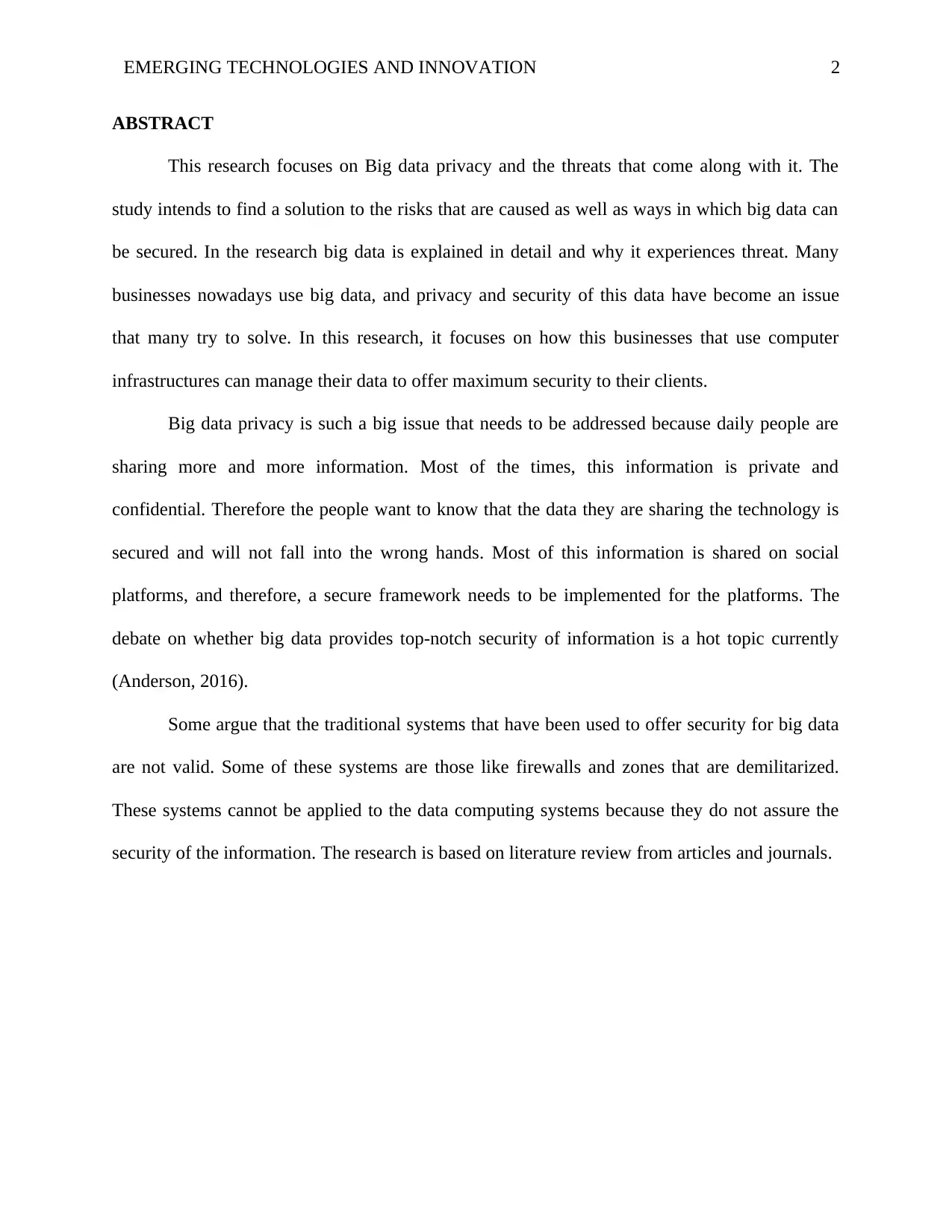
EMERGING TECHNOLOGIES AND INNOVATION 2
ABSTRACT
This research focuses on Big data privacy and the threats that come along with it. The
study intends to find a solution to the risks that are caused as well as ways in which big data can
be secured. In the research big data is explained in detail and why it experiences threat. Many
businesses nowadays use big data, and privacy and security of this data have become an issue
that many try to solve. In this research, it focuses on how this businesses that use computer
infrastructures can manage their data to offer maximum security to their clients.
Big data privacy is such a big issue that needs to be addressed because daily people are
sharing more and more information. Most of the times, this information is private and
confidential. Therefore the people want to know that the data they are sharing the technology is
secured and will not fall into the wrong hands. Most of this information is shared on social
platforms, and therefore, a secure framework needs to be implemented for the platforms. The
debate on whether big data provides top-notch security of information is a hot topic currently
(Anderson, 2016).
Some argue that the traditional systems that have been used to offer security for big data
are not valid. Some of these systems are those like firewalls and zones that are demilitarized.
These systems cannot be applied to the data computing systems because they do not assure the
security of the information. The research is based on literature review from articles and journals.
ABSTRACT
This research focuses on Big data privacy and the threats that come along with it. The
study intends to find a solution to the risks that are caused as well as ways in which big data can
be secured. In the research big data is explained in detail and why it experiences threat. Many
businesses nowadays use big data, and privacy and security of this data have become an issue
that many try to solve. In this research, it focuses on how this businesses that use computer
infrastructures can manage their data to offer maximum security to their clients.
Big data privacy is such a big issue that needs to be addressed because daily people are
sharing more and more information. Most of the times, this information is private and
confidential. Therefore the people want to know that the data they are sharing the technology is
secured and will not fall into the wrong hands. Most of this information is shared on social
platforms, and therefore, a secure framework needs to be implemented for the platforms. The
debate on whether big data provides top-notch security of information is a hot topic currently
(Anderson, 2016).
Some argue that the traditional systems that have been used to offer security for big data
are not valid. Some of these systems are those like firewalls and zones that are demilitarized.
These systems cannot be applied to the data computing systems because they do not assure the
security of the information. The research is based on literature review from articles and journals.
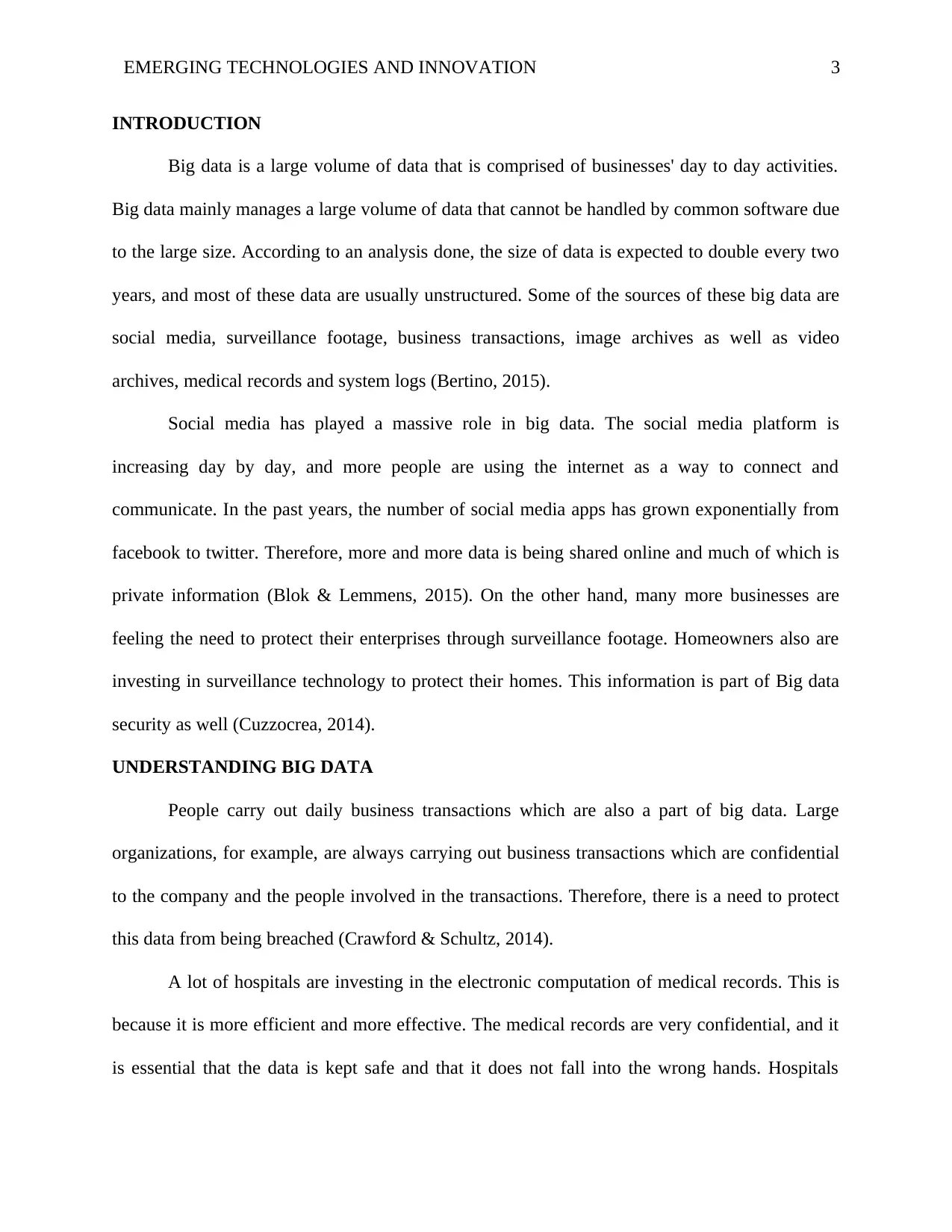
EMERGING TECHNOLOGIES AND INNOVATION 3
INTRODUCTION
Big data is a large volume of data that is comprised of businesses' day to day activities.
Big data mainly manages a large volume of data that cannot be handled by common software due
to the large size. According to an analysis done, the size of data is expected to double every two
years, and most of these data are usually unstructured. Some of the sources of these big data are
social media, surveillance footage, business transactions, image archives as well as video
archives, medical records and system logs (Bertino, 2015).
Social media has played a massive role in big data. The social media platform is
increasing day by day, and more people are using the internet as a way to connect and
communicate. In the past years, the number of social media apps has grown exponentially from
facebook to twitter. Therefore, more and more data is being shared online and much of which is
private information (Blok & Lemmens, 2015). On the other hand, many more businesses are
feeling the need to protect their enterprises through surveillance footage. Homeowners also are
investing in surveillance technology to protect their homes. This information is part of Big data
security as well (Cuzzocrea, 2014).
UNDERSTANDING BIG DATA
People carry out daily business transactions which are also a part of big data. Large
organizations, for example, are always carrying out business transactions which are confidential
to the company and the people involved in the transactions. Therefore, there is a need to protect
this data from being breached (Crawford & Schultz, 2014).
A lot of hospitals are investing in the electronic computation of medical records. This is
because it is more efficient and more effective. The medical records are very confidential, and it
is essential that the data is kept safe and that it does not fall into the wrong hands. Hospitals
INTRODUCTION
Big data is a large volume of data that is comprised of businesses' day to day activities.
Big data mainly manages a large volume of data that cannot be handled by common software due
to the large size. According to an analysis done, the size of data is expected to double every two
years, and most of these data are usually unstructured. Some of the sources of these big data are
social media, surveillance footage, business transactions, image archives as well as video
archives, medical records and system logs (Bertino, 2015).
Social media has played a massive role in big data. The social media platform is
increasing day by day, and more people are using the internet as a way to connect and
communicate. In the past years, the number of social media apps has grown exponentially from
facebook to twitter. Therefore, more and more data is being shared online and much of which is
private information (Blok & Lemmens, 2015). On the other hand, many more businesses are
feeling the need to protect their enterprises through surveillance footage. Homeowners also are
investing in surveillance technology to protect their homes. This information is part of Big data
security as well (Cuzzocrea, 2014).
UNDERSTANDING BIG DATA
People carry out daily business transactions which are also a part of big data. Large
organizations, for example, are always carrying out business transactions which are confidential
to the company and the people involved in the transactions. Therefore, there is a need to protect
this data from being breached (Crawford & Schultz, 2014).
A lot of hospitals are investing in the electronic computation of medical records. This is
because it is more efficient and more effective. The medical records are very confidential, and it
is essential that the data is kept safe and that it does not fall into the wrong hands. Hospitals
⊘ This is a preview!⊘
Do you want full access?
Subscribe today to unlock all pages.

Trusted by 1+ million students worldwide

EMERGING TECHNOLOGIES AND INNOVATION 4
consider Big data privacy as a very hot topic because they want to ensure that their data and that
of their patients are safe (Chin, Fan & Haines, 2014).
Lastly, we have video and image archives and in this instance, many people are storing
their images and videos on the cloud. This is an efficient way to save the space in their phones
and computers and also practical storage. However, some raise the concerns of whether this
information stored in the cloud is safe. They want to be assured that their data is secured (Da Xu,
He & Li, 2014).
There is an increased number of devices that are connected to the Internet, and this raises
more concerns for big data because more and more data is being produced. This data needs to be
transformed into valuable information for use. Nowadays, one can purchase storage of data from
public cloud providers. Public clouds have managed to help big data to expand. This has led to
the decreased use of traditional ways of data security such as firewalls. This is because they are
no longer effective as they cannot support the massive amounts of data (Dastjerdi & Buyya,
2016).
The security that is required for big data needs to be heterogeneous, and the hardware and
operating systems need to be diverse. For one to make big data secure, then they need to consider
the use of the Software-Defined network (SDN). An SDN is very important to big data and to
solve the issues of privacy and security that come along with it (Hashem et al., 2015). The
network separates the control plane from the infrastructure which allows the administrators to
write programs that can specify how an entire network behaves. This contrasts with the
traditional networks that force the administrator to code the functionality of the system
(Gandomi & Haider, 2015).
consider Big data privacy as a very hot topic because they want to ensure that their data and that
of their patients are safe (Chin, Fan & Haines, 2014).
Lastly, we have video and image archives and in this instance, many people are storing
their images and videos on the cloud. This is an efficient way to save the space in their phones
and computers and also practical storage. However, some raise the concerns of whether this
information stored in the cloud is safe. They want to be assured that their data is secured (Da Xu,
He & Li, 2014).
There is an increased number of devices that are connected to the Internet, and this raises
more concerns for big data because more and more data is being produced. This data needs to be
transformed into valuable information for use. Nowadays, one can purchase storage of data from
public cloud providers. Public clouds have managed to help big data to expand. This has led to
the decreased use of traditional ways of data security such as firewalls. This is because they are
no longer effective as they cannot support the massive amounts of data (Dastjerdi & Buyya,
2016).
The security that is required for big data needs to be heterogeneous, and the hardware and
operating systems need to be diverse. For one to make big data secure, then they need to consider
the use of the Software-Defined network (SDN). An SDN is very important to big data and to
solve the issues of privacy and security that come along with it (Hashem et al., 2015). The
network separates the control plane from the infrastructure which allows the administrators to
write programs that can specify how an entire network behaves. This contrasts with the
traditional networks that force the administrator to code the functionality of the system
(Gandomi & Haider, 2015).
Paraphrase This Document
Need a fresh take? Get an instant paraphrase of this document with our AI Paraphraser
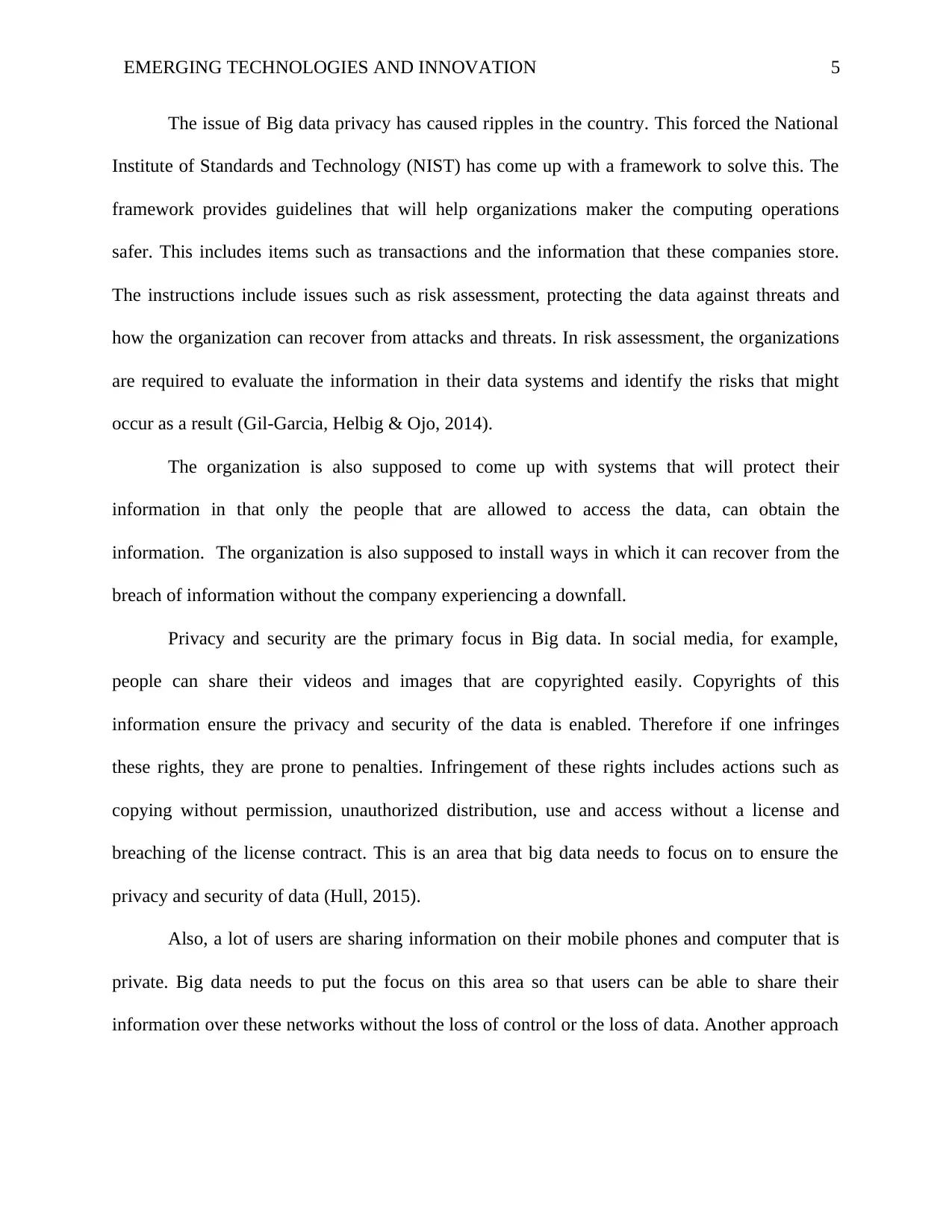
EMERGING TECHNOLOGIES AND INNOVATION 5
The issue of Big data privacy has caused ripples in the country. This forced the National
Institute of Standards and Technology (NIST) has come up with a framework to solve this. The
framework provides guidelines that will help organizations maker the computing operations
safer. This includes items such as transactions and the information that these companies store.
The instructions include issues such as risk assessment, protecting the data against threats and
how the organization can recover from attacks and threats. In risk assessment, the organizations
are required to evaluate the information in their data systems and identify the risks that might
occur as a result (Gil-Garcia, Helbig & Ojo, 2014).
The organization is also supposed to come up with systems that will protect their
information in that only the people that are allowed to access the data, can obtain the
information. The organization is also supposed to install ways in which it can recover from the
breach of information without the company experiencing a downfall.
Privacy and security are the primary focus in Big data. In social media, for example,
people can share their videos and images that are copyrighted easily. Copyrights of this
information ensure the privacy and security of the data is enabled. Therefore if one infringes
these rights, they are prone to penalties. Infringement of these rights includes actions such as
copying without permission, unauthorized distribution, use and access without a license and
breaching of the license contract. This is an area that big data needs to focus on to ensure the
privacy and security of data (Hull, 2015).
Also, a lot of users are sharing information on their mobile phones and computer that is
private. Big data needs to put the focus on this area so that users can be able to share their
information over these networks without the loss of control or the loss of data. Another approach
The issue of Big data privacy has caused ripples in the country. This forced the National
Institute of Standards and Technology (NIST) has come up with a framework to solve this. The
framework provides guidelines that will help organizations maker the computing operations
safer. This includes items such as transactions and the information that these companies store.
The instructions include issues such as risk assessment, protecting the data against threats and
how the organization can recover from attacks and threats. In risk assessment, the organizations
are required to evaluate the information in their data systems and identify the risks that might
occur as a result (Gil-Garcia, Helbig & Ojo, 2014).
The organization is also supposed to come up with systems that will protect their
information in that only the people that are allowed to access the data, can obtain the
information. The organization is also supposed to install ways in which it can recover from the
breach of information without the company experiencing a downfall.
Privacy and security are the primary focus in Big data. In social media, for example,
people can share their videos and images that are copyrighted easily. Copyrights of this
information ensure the privacy and security of the data is enabled. Therefore if one infringes
these rights, they are prone to penalties. Infringement of these rights includes actions such as
copying without permission, unauthorized distribution, use and access without a license and
breaching of the license contract. This is an area that big data needs to focus on to ensure the
privacy and security of data (Hull, 2015).
Also, a lot of users are sharing information on their mobile phones and computer that is
private. Big data needs to put the focus on this area so that users can be able to share their
information over these networks without the loss of control or the loss of data. Another approach

EMERGING TECHNOLOGIES AND INNOVATION 6
that big data can take is to create uncertainty for hackers. This way the attackers are unable to
access this information in the data systems (Köhler & Som, 2014).
CHALLENGES TO BIG DATA PRIVACY AND SECURITY
Big data might be described just based on its size. Nevertheless, in the generation of a
fundamental understanding, Big Data denote datasets that cannot be processed in traditional
database means to their size. This type of data accumulation assists enhance customer care
service in various ways (Moreno, Serrano & Fernández-Medina, 2016). Nevertheless, such
enormous quantity of data are further able to be accompanied by several issues of privacy,
thereby rendering the Big Data Security a key concern for various organizations. Working in
data security and privacy’s field, several firms are recognizing these threats and subsequently
implementing measure for their effective prevention (Narayanan, Huey & Felten, 2016).
Big Data Security Issues are rising
Big Data (BD) is not novel to huge firms, nonetheless, it is further being famous among
SMEs as a result of reduction in cost and availed ease for data management. The cloud-oriented
stowage has enhanced data mining as well as gathering. Nevertheless, this BD and cloud stowage
integration has triggered a severe challenge to both security and privacy threats (Perera et al.,
2015). The rationale for such breaches could further be that security applications designed for
storing some quantities of data are unable to be big volume of data which the above-mentioned
datasets contain (Pimm et al., 2015). Moreover, such security technologies remain inefficient in
managing dynamic data and are to control static data solely (Popescu, Baruh, Popescu, Baruh,
Messaris & Humphreys, 2017). Hence, just a regular security check is unable to effect detection
of security patches for ongoing streaming data. Therefore, one needs full-time privacy while data
analysis and data streaming.
that big data can take is to create uncertainty for hackers. This way the attackers are unable to
access this information in the data systems (Köhler & Som, 2014).
CHALLENGES TO BIG DATA PRIVACY AND SECURITY
Big data might be described just based on its size. Nevertheless, in the generation of a
fundamental understanding, Big Data denote datasets that cannot be processed in traditional
database means to their size. This type of data accumulation assists enhance customer care
service in various ways (Moreno, Serrano & Fernández-Medina, 2016). Nevertheless, such
enormous quantity of data are further able to be accompanied by several issues of privacy,
thereby rendering the Big Data Security a key concern for various organizations. Working in
data security and privacy’s field, several firms are recognizing these threats and subsequently
implementing measure for their effective prevention (Narayanan, Huey & Felten, 2016).
Big Data Security Issues are rising
Big Data (BD) is not novel to huge firms, nonetheless, it is further being famous among
SMEs as a result of reduction in cost and availed ease for data management. The cloud-oriented
stowage has enhanced data mining as well as gathering. Nevertheless, this BD and cloud stowage
integration has triggered a severe challenge to both security and privacy threats (Perera et al.,
2015). The rationale for such breaches could further be that security applications designed for
storing some quantities of data are unable to be big volume of data which the above-mentioned
datasets contain (Pimm et al., 2015). Moreover, such security technologies remain inefficient in
managing dynamic data and are to control static data solely (Popescu, Baruh, Popescu, Baruh,
Messaris & Humphreys, 2017). Hence, just a regular security check is unable to effect detection
of security patches for ongoing streaming data. Therefore, one needs full-time privacy while data
analysis and data streaming.
⊘ This is a preview!⊘
Do you want full access?
Subscribe today to unlock all pages.

Trusted by 1+ million students worldwide
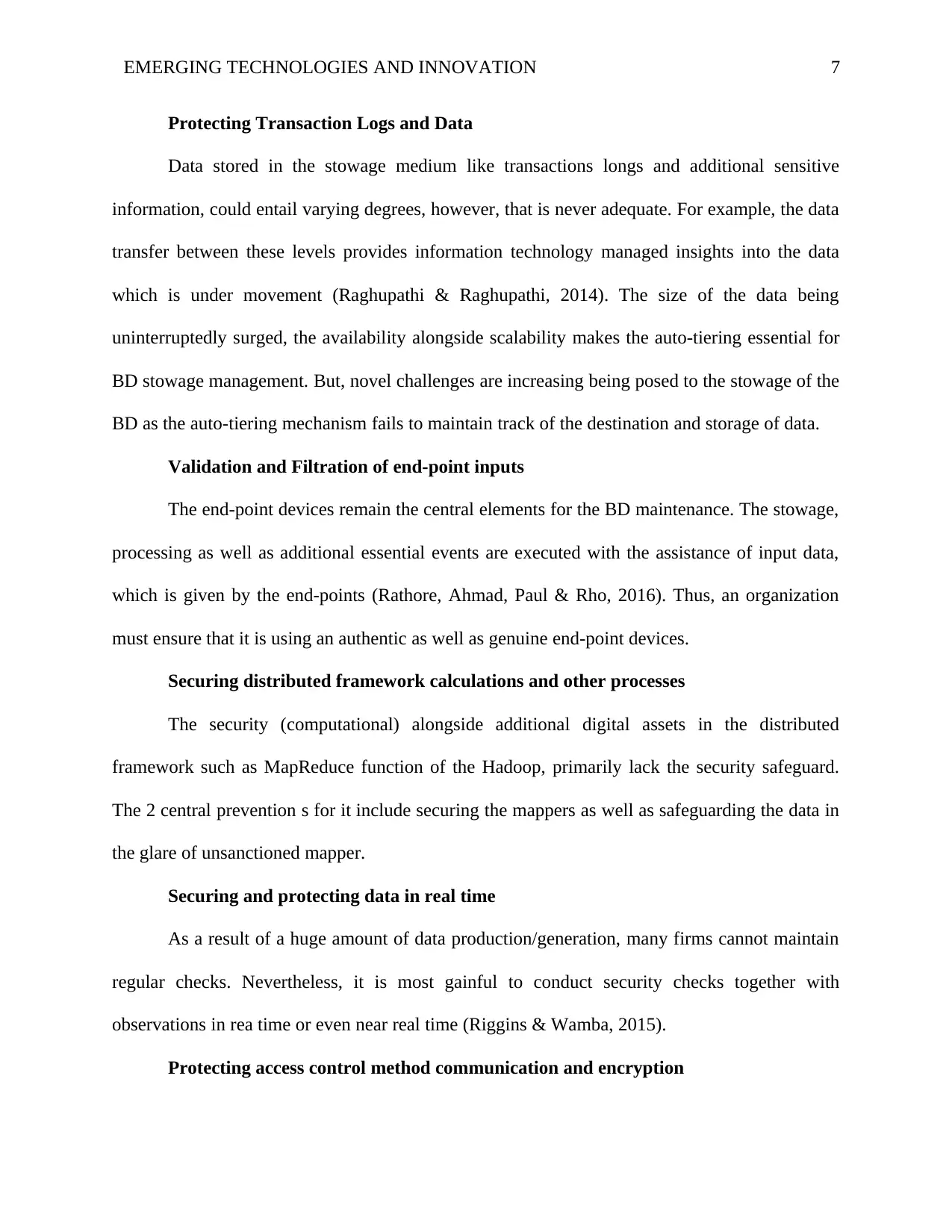
EMERGING TECHNOLOGIES AND INNOVATION 7
Protecting Transaction Logs and Data
Data stored in the stowage medium like transactions longs and additional sensitive
information, could entail varying degrees, however, that is never adequate. For example, the data
transfer between these levels provides information technology managed insights into the data
which is under movement (Raghupathi & Raghupathi, 2014). The size of the data being
uninterruptedly surged, the availability alongside scalability makes the auto-tiering essential for
BD stowage management. But, novel challenges are increasing being posed to the stowage of the
BD as the auto-tiering mechanism fails to maintain track of the destination and storage of data.
Validation and Filtration of end-point inputs
The end-point devices remain the central elements for the BD maintenance. The stowage,
processing as well as additional essential events are executed with the assistance of input data,
which is given by the end-points (Rathore, Ahmad, Paul & Rho, 2016). Thus, an organization
must ensure that it is using an authentic as well as genuine end-point devices.
Securing distributed framework calculations and other processes
The security (computational) alongside additional digital assets in the distributed
framework such as MapReduce function of the Hadoop, primarily lack the security safeguard.
The 2 central prevention s for it include securing the mappers as well as safeguarding the data in
the glare of unsanctioned mapper.
Securing and protecting data in real time
As a result of a huge amount of data production/generation, many firms cannot maintain
regular checks. Nevertheless, it is most gainful to conduct security checks together with
observations in rea time or even near real time (Riggins & Wamba, 2015).
Protecting access control method communication and encryption
Protecting Transaction Logs and Data
Data stored in the stowage medium like transactions longs and additional sensitive
information, could entail varying degrees, however, that is never adequate. For example, the data
transfer between these levels provides information technology managed insights into the data
which is under movement (Raghupathi & Raghupathi, 2014). The size of the data being
uninterruptedly surged, the availability alongside scalability makes the auto-tiering essential for
BD stowage management. But, novel challenges are increasing being posed to the stowage of the
BD as the auto-tiering mechanism fails to maintain track of the destination and storage of data.
Validation and Filtration of end-point inputs
The end-point devices remain the central elements for the BD maintenance. The stowage,
processing as well as additional essential events are executed with the assistance of input data,
which is given by the end-points (Rathore, Ahmad, Paul & Rho, 2016). Thus, an organization
must ensure that it is using an authentic as well as genuine end-point devices.
Securing distributed framework calculations and other processes
The security (computational) alongside additional digital assets in the distributed
framework such as MapReduce function of the Hadoop, primarily lack the security safeguard.
The 2 central prevention s for it include securing the mappers as well as safeguarding the data in
the glare of unsanctioned mapper.
Securing and protecting data in real time
As a result of a huge amount of data production/generation, many firms cannot maintain
regular checks. Nevertheless, it is most gainful to conduct security checks together with
observations in rea time or even near real time (Riggins & Wamba, 2015).
Protecting access control method communication and encryption
Paraphrase This Document
Need a fresh take? Get an instant paraphrase of this document with our AI Paraphraser
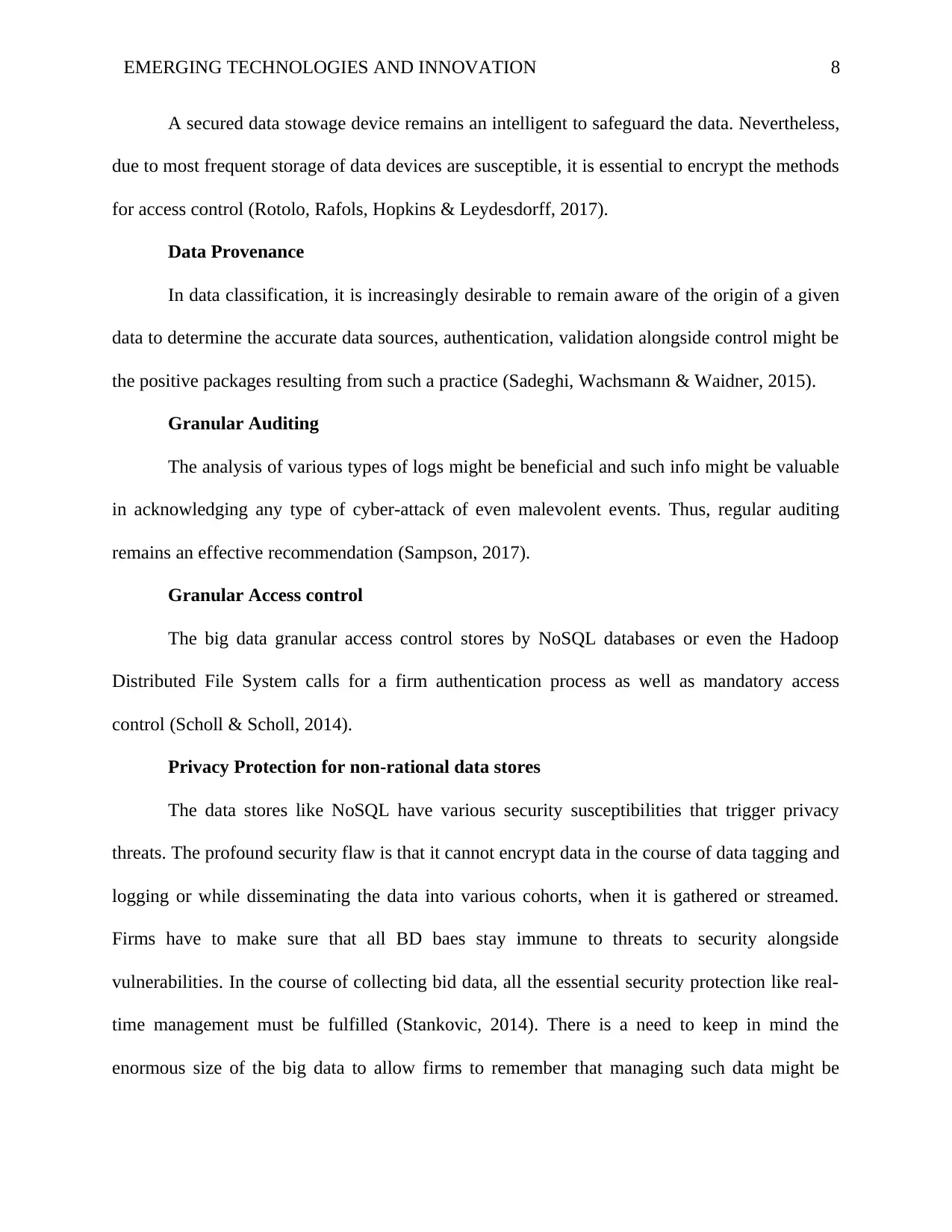
EMERGING TECHNOLOGIES AND INNOVATION 8
A secured data stowage device remains an intelligent to safeguard the data. Nevertheless,
due to most frequent storage of data devices are susceptible, it is essential to encrypt the methods
for access control (Rotolo, Rafols, Hopkins & Leydesdorff, 2017).
Data Provenance
In data classification, it is increasingly desirable to remain aware of the origin of a given
data to determine the accurate data sources, authentication, validation alongside control might be
the positive packages resulting from such a practice (Sadeghi, Wachsmann & Waidner, 2015).
Granular Auditing
The analysis of various types of logs might be beneficial and such info might be valuable
in acknowledging any type of cyber-attack of even malevolent events. Thus, regular auditing
remains an effective recommendation (Sampson, 2017).
Granular Access control
The big data granular access control stores by NoSQL databases or even the Hadoop
Distributed File System calls for a firm authentication process as well as mandatory access
control (Scholl & Scholl, 2014).
Privacy Protection for non-rational data stores
The data stores like NoSQL have various security susceptibilities that trigger privacy
threats. The profound security flaw is that it cannot encrypt data in the course of data tagging and
logging or while disseminating the data into various cohorts, when it is gathered or streamed.
Firms have to make sure that all BD baes stay immune to threats to security alongside
vulnerabilities. In the course of collecting bid data, all the essential security protection like real-
time management must be fulfilled (Stankovic, 2014). There is a need to keep in mind the
enormous size of the big data to allow firms to remember that managing such data might be
A secured data stowage device remains an intelligent to safeguard the data. Nevertheless,
due to most frequent storage of data devices are susceptible, it is essential to encrypt the methods
for access control (Rotolo, Rafols, Hopkins & Leydesdorff, 2017).
Data Provenance
In data classification, it is increasingly desirable to remain aware of the origin of a given
data to determine the accurate data sources, authentication, validation alongside control might be
the positive packages resulting from such a practice (Sadeghi, Wachsmann & Waidner, 2015).
Granular Auditing
The analysis of various types of logs might be beneficial and such info might be valuable
in acknowledging any type of cyber-attack of even malevolent events. Thus, regular auditing
remains an effective recommendation (Sampson, 2017).
Granular Access control
The big data granular access control stores by NoSQL databases or even the Hadoop
Distributed File System calls for a firm authentication process as well as mandatory access
control (Scholl & Scholl, 2014).
Privacy Protection for non-rational data stores
The data stores like NoSQL have various security susceptibilities that trigger privacy
threats. The profound security flaw is that it cannot encrypt data in the course of data tagging and
logging or while disseminating the data into various cohorts, when it is gathered or streamed.
Firms have to make sure that all BD baes stay immune to threats to security alongside
vulnerabilities. In the course of collecting bid data, all the essential security protection like real-
time management must be fulfilled (Stankovic, 2014). There is a need to keep in mind the
enormous size of the big data to allow firms to remember that managing such data might be
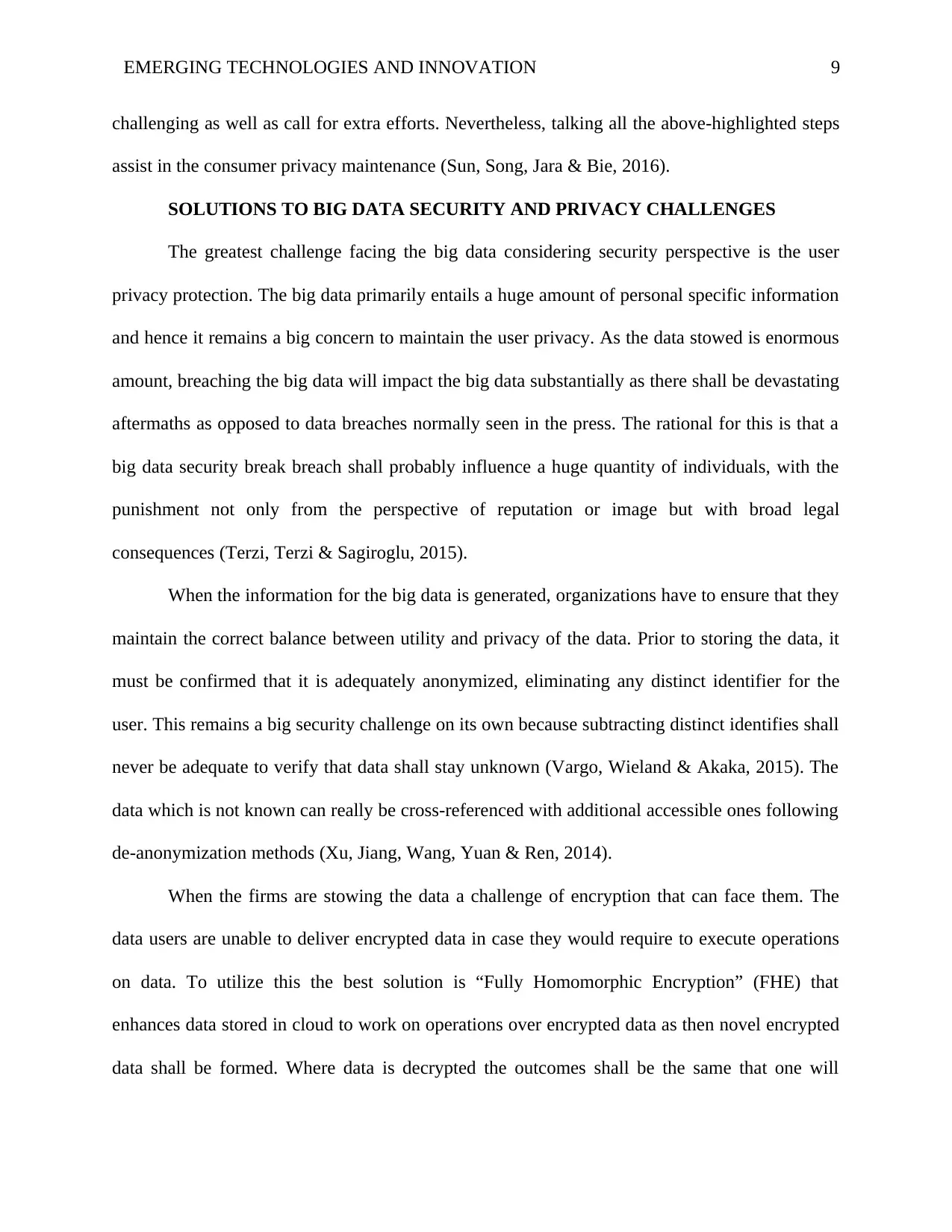
EMERGING TECHNOLOGIES AND INNOVATION 9
challenging as well as call for extra efforts. Nevertheless, talking all the above-highlighted steps
assist in the consumer privacy maintenance (Sun, Song, Jara & Bie, 2016).
SOLUTIONS TO BIG DATA SECURITY AND PRIVACY CHALLENGES
The greatest challenge facing the big data considering security perspective is the user
privacy protection. The big data primarily entails a huge amount of personal specific information
and hence it remains a big concern to maintain the user privacy. As the data stowed is enormous
amount, breaching the big data will impact the big data substantially as there shall be devastating
aftermaths as opposed to data breaches normally seen in the press. The rational for this is that a
big data security break breach shall probably influence a huge quantity of individuals, with the
punishment not only from the perspective of reputation or image but with broad legal
consequences (Terzi, Terzi & Sagiroglu, 2015).
When the information for the big data is generated, organizations have to ensure that they
maintain the correct balance between utility and privacy of the data. Prior to storing the data, it
must be confirmed that it is adequately anonymized, eliminating any distinct identifier for the
user. This remains a big security challenge on its own because subtracting distinct identifies shall
never be adequate to verify that data shall stay unknown (Vargo, Wieland & Akaka, 2015). The
data which is not known can really be cross-referenced with additional accessible ones following
de-anonymization methods (Xu, Jiang, Wang, Yuan & Ren, 2014).
When the firms are stowing the data a challenge of encryption that can face them. The
data users are unable to deliver encrypted data in case they would require to execute operations
on data. To utilize this the best solution is “Fully Homomorphic Encryption” (FHE) that
enhances data stored in cloud to work on operations over encrypted data as then novel encrypted
data shall be formed. Where data is decrypted the outcomes shall be the same that one will
challenging as well as call for extra efforts. Nevertheless, talking all the above-highlighted steps
assist in the consumer privacy maintenance (Sun, Song, Jara & Bie, 2016).
SOLUTIONS TO BIG DATA SECURITY AND PRIVACY CHALLENGES
The greatest challenge facing the big data considering security perspective is the user
privacy protection. The big data primarily entails a huge amount of personal specific information
and hence it remains a big concern to maintain the user privacy. As the data stowed is enormous
amount, breaching the big data will impact the big data substantially as there shall be devastating
aftermaths as opposed to data breaches normally seen in the press. The rational for this is that a
big data security break breach shall probably influence a huge quantity of individuals, with the
punishment not only from the perspective of reputation or image but with broad legal
consequences (Terzi, Terzi & Sagiroglu, 2015).
When the information for the big data is generated, organizations have to ensure that they
maintain the correct balance between utility and privacy of the data. Prior to storing the data, it
must be confirmed that it is adequately anonymized, eliminating any distinct identifier for the
user. This remains a big security challenge on its own because subtracting distinct identifies shall
never be adequate to verify that data shall stay unknown (Vargo, Wieland & Akaka, 2015). The
data which is not known can really be cross-referenced with additional accessible ones following
de-anonymization methods (Xu, Jiang, Wang, Yuan & Ren, 2014).
When the firms are stowing the data a challenge of encryption that can face them. The
data users are unable to deliver encrypted data in case they would require to execute operations
on data. To utilize this the best solution is “Fully Homomorphic Encryption” (FHE) that
enhances data stored in cloud to work on operations over encrypted data as then novel encrypted
data shall be formed. Where data is decrypted the outcomes shall be the same that one will
⊘ This is a preview!⊘
Do you want full access?
Subscribe today to unlock all pages.

Trusted by 1+ million students worldwide
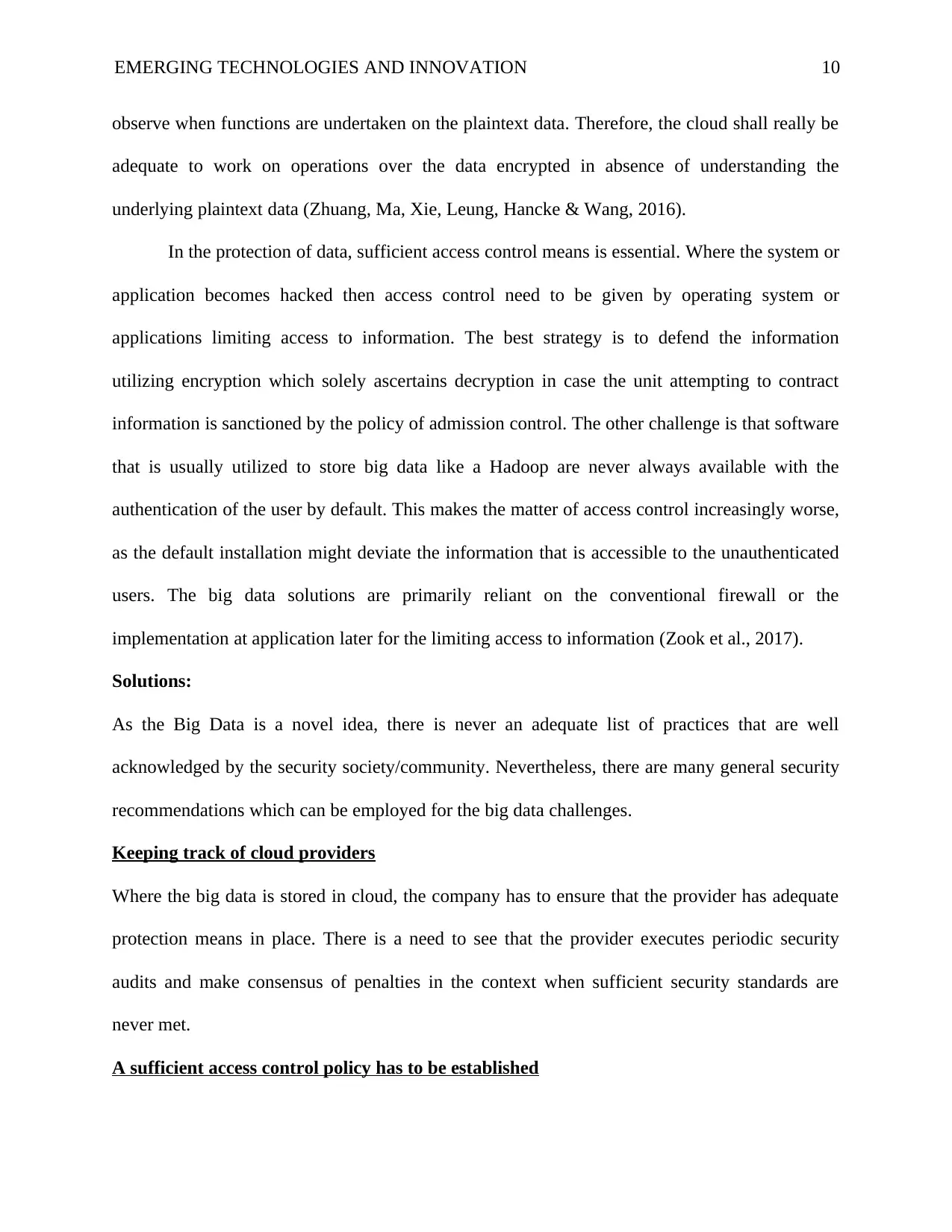
EMERGING TECHNOLOGIES AND INNOVATION 10
observe when functions are undertaken on the plaintext data. Therefore, the cloud shall really be
adequate to work on operations over the data encrypted in absence of understanding the
underlying plaintext data (Zhuang, Ma, Xie, Leung, Hancke & Wang, 2016).
In the protection of data, sufficient access control means is essential. Where the system or
application becomes hacked then access control need to be given by operating system or
applications limiting access to information. The best strategy is to defend the information
utilizing encryption which solely ascertains decryption in case the unit attempting to contract
information is sanctioned by the policy of admission control. The other challenge is that software
that is usually utilized to store big data like a Hadoop are never always available with the
authentication of the user by default. This makes the matter of access control increasingly worse,
as the default installation might deviate the information that is accessible to the unauthenticated
users. The big data solutions are primarily reliant on the conventional firewall or the
implementation at application later for the limiting access to information (Zook et al., 2017).
Solutions:
As the Big Data is a novel idea, there is never an adequate list of practices that are well
acknowledged by the security society/community. Nevertheless, there are many general security
recommendations which can be employed for the big data challenges.
Keeping track of cloud providers
Where the big data is stored in cloud, the company has to ensure that the provider has adequate
protection means in place. There is a need to see that the provider executes periodic security
audits and make consensus of penalties in the context when sufficient security standards are
never met.
A sufficient access control policy has to be established
observe when functions are undertaken on the plaintext data. Therefore, the cloud shall really be
adequate to work on operations over the data encrypted in absence of understanding the
underlying plaintext data (Zhuang, Ma, Xie, Leung, Hancke & Wang, 2016).
In the protection of data, sufficient access control means is essential. Where the system or
application becomes hacked then access control need to be given by operating system or
applications limiting access to information. The best strategy is to defend the information
utilizing encryption which solely ascertains decryption in case the unit attempting to contract
information is sanctioned by the policy of admission control. The other challenge is that software
that is usually utilized to store big data like a Hadoop are never always available with the
authentication of the user by default. This makes the matter of access control increasingly worse,
as the default installation might deviate the information that is accessible to the unauthenticated
users. The big data solutions are primarily reliant on the conventional firewall or the
implementation at application later for the limiting access to information (Zook et al., 2017).
Solutions:
As the Big Data is a novel idea, there is never an adequate list of practices that are well
acknowledged by the security society/community. Nevertheless, there are many general security
recommendations which can be employed for the big data challenges.
Keeping track of cloud providers
Where the big data is stored in cloud, the company has to ensure that the provider has adequate
protection means in place. There is a need to see that the provider executes periodic security
audits and make consensus of penalties in the context when sufficient security standards are
never met.
A sufficient access control policy has to be established
Paraphrase This Document
Need a fresh take? Get an instant paraphrase of this document with our AI Paraphraser
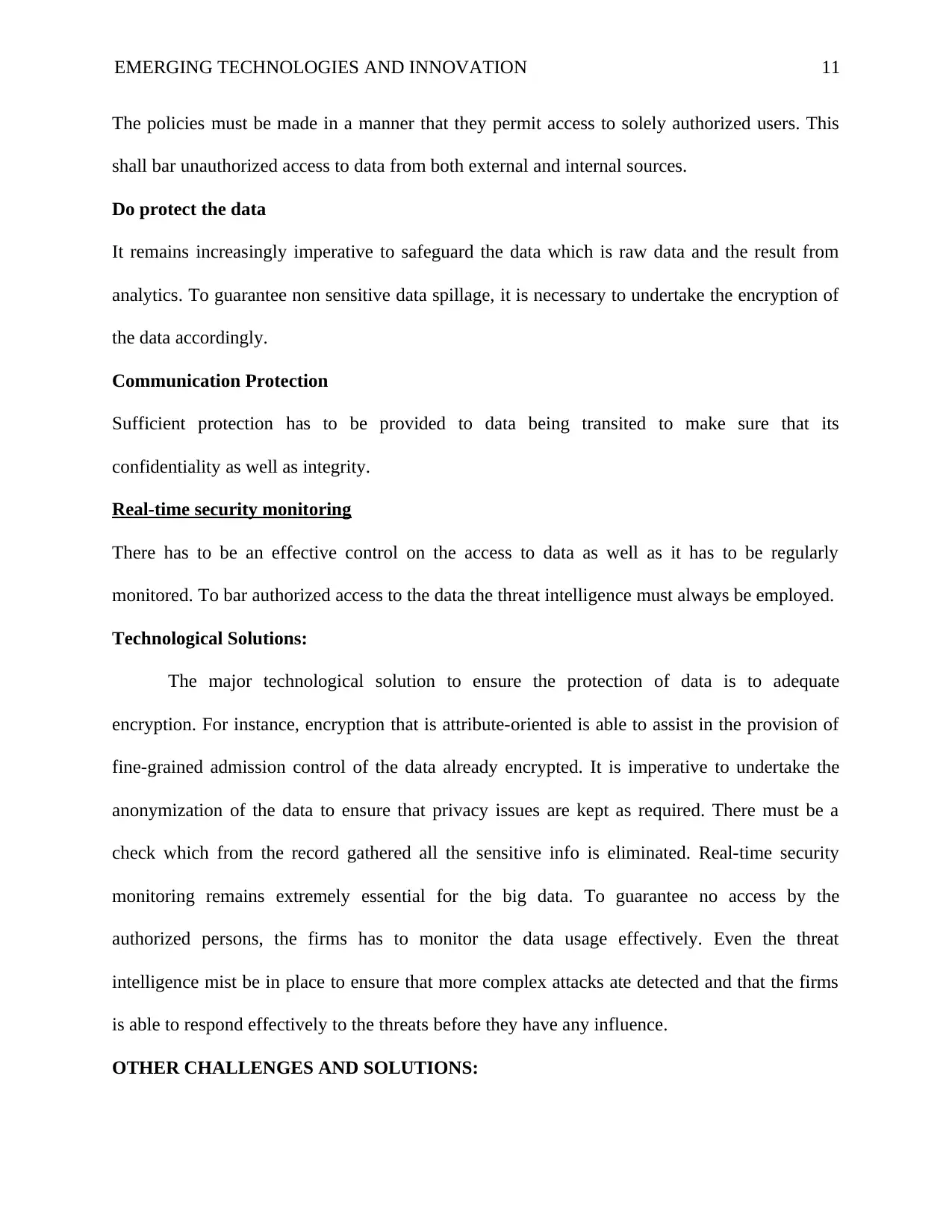
EMERGING TECHNOLOGIES AND INNOVATION 11
The policies must be made in a manner that they permit access to solely authorized users. This
shall bar unauthorized access to data from both external and internal sources.
Do protect the data
It remains increasingly imperative to safeguard the data which is raw data and the result from
analytics. To guarantee non sensitive data spillage, it is necessary to undertake the encryption of
the data accordingly.
Communication Protection
Sufficient protection has to be provided to data being transited to make sure that its
confidentiality as well as integrity.
Real-time security monitoring
There has to be an effective control on the access to data as well as it has to be regularly
monitored. To bar authorized access to the data the threat intelligence must always be employed.
Technological Solutions:
The major technological solution to ensure the protection of data is to adequate
encryption. For instance, encryption that is attribute-oriented is able to assist in the provision of
fine-grained admission control of the data already encrypted. It is imperative to undertake the
anonymization of the data to ensure that privacy issues are kept as required. There must be a
check which from the record gathered all the sensitive info is eliminated. Real-time security
monitoring remains extremely essential for the big data. To guarantee no access by the
authorized persons, the firms has to monitor the data usage effectively. Even the threat
intelligence mist be in place to ensure that more complex attacks ate detected and that the firms
is able to respond effectively to the threats before they have any influence.
OTHER CHALLENGES AND SOLUTIONS:
The policies must be made in a manner that they permit access to solely authorized users. This
shall bar unauthorized access to data from both external and internal sources.
Do protect the data
It remains increasingly imperative to safeguard the data which is raw data and the result from
analytics. To guarantee non sensitive data spillage, it is necessary to undertake the encryption of
the data accordingly.
Communication Protection
Sufficient protection has to be provided to data being transited to make sure that its
confidentiality as well as integrity.
Real-time security monitoring
There has to be an effective control on the access to data as well as it has to be regularly
monitored. To bar authorized access to the data the threat intelligence must always be employed.
Technological Solutions:
The major technological solution to ensure the protection of data is to adequate
encryption. For instance, encryption that is attribute-oriented is able to assist in the provision of
fine-grained admission control of the data already encrypted. It is imperative to undertake the
anonymization of the data to ensure that privacy issues are kept as required. There must be a
check which from the record gathered all the sensitive info is eliminated. Real-time security
monitoring remains extremely essential for the big data. To guarantee no access by the
authorized persons, the firms has to monitor the data usage effectively. Even the threat
intelligence mist be in place to ensure that more complex attacks ate detected and that the firms
is able to respond effectively to the threats before they have any influence.
OTHER CHALLENGES AND SOLUTIONS:
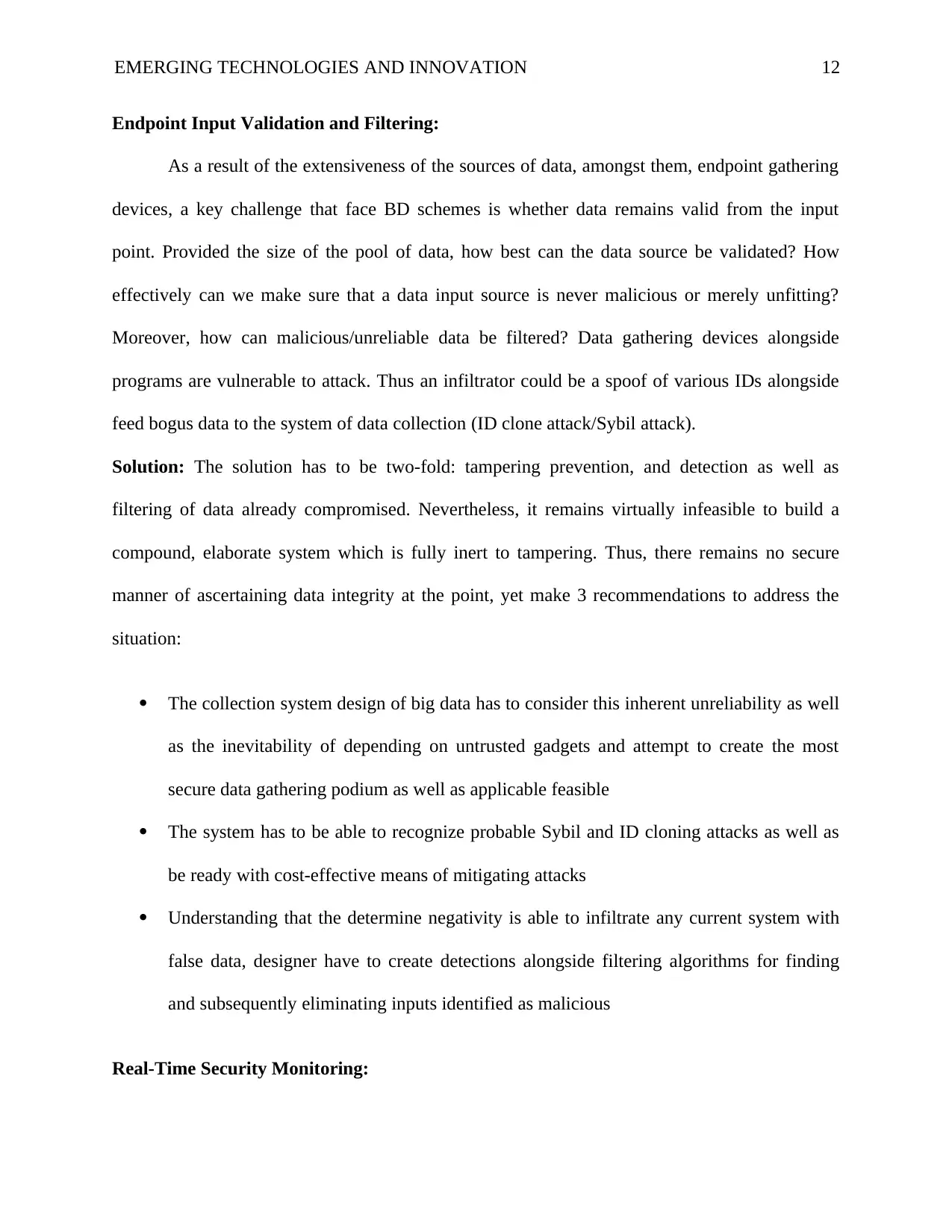
EMERGING TECHNOLOGIES AND INNOVATION 12
Endpoint Input Validation and Filtering:
As a result of the extensiveness of the sources of data, amongst them, endpoint gathering
devices, a key challenge that face BD schemes is whether data remains valid from the input
point. Provided the size of the pool of data, how best can the data source be validated? How
effectively can we make sure that a data input source is never malicious or merely unfitting?
Moreover, how can malicious/unreliable data be filtered? Data gathering devices alongside
programs are vulnerable to attack. Thus an infiltrator could be a spoof of various IDs alongside
feed bogus data to the system of data collection (ID clone attack/Sybil attack).
Solution: The solution has to be two-fold: tampering prevention, and detection as well as
filtering of data already compromised. Nevertheless, it remains virtually infeasible to build a
compound, elaborate system which is fully inert to tampering. Thus, there remains no secure
manner of ascertaining data integrity at the point, yet make 3 recommendations to address the
situation:
The collection system design of big data has to consider this inherent unreliability as well
as the inevitability of depending on untrusted gadgets and attempt to create the most
secure data gathering podium as well as applicable feasible
The system has to be able to recognize probable Sybil and ID cloning attacks as well as
be ready with cost-effective means of mitigating attacks
Understanding that the determine negativity is able to infiltrate any current system with
false data, designer have to create detections alongside filtering algorithms for finding
and subsequently eliminating inputs identified as malicious
Real-Time Security Monitoring:
Endpoint Input Validation and Filtering:
As a result of the extensiveness of the sources of data, amongst them, endpoint gathering
devices, a key challenge that face BD schemes is whether data remains valid from the input
point. Provided the size of the pool of data, how best can the data source be validated? How
effectively can we make sure that a data input source is never malicious or merely unfitting?
Moreover, how can malicious/unreliable data be filtered? Data gathering devices alongside
programs are vulnerable to attack. Thus an infiltrator could be a spoof of various IDs alongside
feed bogus data to the system of data collection (ID clone attack/Sybil attack).
Solution: The solution has to be two-fold: tampering prevention, and detection as well as
filtering of data already compromised. Nevertheless, it remains virtually infeasible to build a
compound, elaborate system which is fully inert to tampering. Thus, there remains no secure
manner of ascertaining data integrity at the point, yet make 3 recommendations to address the
situation:
The collection system design of big data has to consider this inherent unreliability as well
as the inevitability of depending on untrusted gadgets and attempt to create the most
secure data gathering podium as well as applicable feasible
The system has to be able to recognize probable Sybil and ID cloning attacks as well as
be ready with cost-effective means of mitigating attacks
Understanding that the determine negativity is able to infiltrate any current system with
false data, designer have to create detections alongside filtering algorithms for finding
and subsequently eliminating inputs identified as malicious
Real-Time Security Monitoring:
⊘ This is a preview!⊘
Do you want full access?
Subscribe today to unlock all pages.

Trusted by 1+ million students worldwide
1 out of 22
Related Documents
Your All-in-One AI-Powered Toolkit for Academic Success.
+13062052269
info@desklib.com
Available 24*7 on WhatsApp / Email
![[object Object]](/_next/static/media/star-bottom.7253800d.svg)
Unlock your academic potential
Copyright © 2020–2025 A2Z Services. All Rights Reserved. Developed and managed by ZUCOL.




